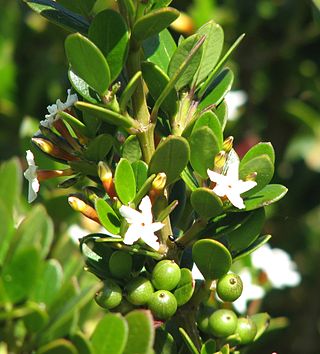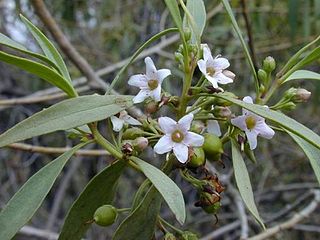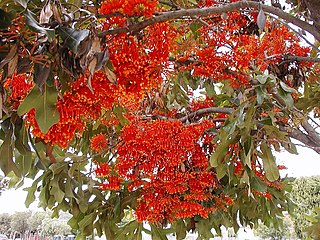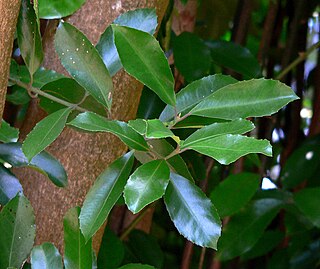
Xylosma is a genus of flowering plants in the family Salicaceae. It contains around 100 species of evergreen shrubs and trees commonly known as brushhollies, xylosmas, or, more ambiguously, "logwoods". The generic name is derived from the Greek words ξύλον (xylon), meaning "wood, tree", and ὀσμή (osmé), meaning "smell", referring to the fragrant wood of some of the species. The Takhtajan system places it in the family Flacourtiaceae, which is considered defunct by the Angiosperm Phylogeny Group.

Alyxia is an Australasian genus of flowering plant in the dogbane family, Apocynaceae. It contains at present 106 species, but Alyxia stellata and A. tisserantii are very variable, might be cryptic species complexes, and are need of further study. It consists of shrubby, climbing or scrambling plants. This genus occurs in China, the Himalayas, Southeast Asia, Australia, New Caledonia and the Pacific Islands. There are 14 species in Australia, 21 in New Caledonia and 7 in the other Pacific Islands, including Hawaiʻi.

Argophyllaceae is a family of shrubs or small trees belonging to the order Asterales. The family includes c. 24 species in two genera, Argophyllum and Corokia. Members of the family are native to eastern Australia, New Zealand, Lord Howe Island, New Caledonia, and Rapa Iti.

Myoporum is a genus of flowering plants in the figwort family, Scrophulariaceae. There are 30 species in the genus, eighteen of which are endemic to Australia although others are endemic to Pacific Islands, including New Zealand, and one is endemic to two Indian Ocean islands. They are shrubs or small trees with leaves that are arranged alternately and have white, occasionally pink flowers and a fruit that is a drupe.
Phelline is a genus of shrubs and the sole member of the family Phellinaceae, a family of flowering plants endemic to New Caledonia. It is placed in the order Asterales and is related to two other small plant families: Alseuosmiaceae and Argophyllaceae. It contains ten species.

Schefflera is a genus of flowering plants in the family Araliaceae with 13 species native to New Zealand and some Pacific islands.

Stenocarpus is a genus of about 22 species of flowering plants in the family Proteaceae. They are trees or shrubs with variably-shaped leaves, zygomorphic, bisexual flowers, the floral tube opening on the lower side before separating into four parts, followed by fruit that is usually a narrow oblong or cylindrical follicle.

Zieria is a genus of plants in the family, Rutaceae. About sixty species have been formally described, all of which are endemic to Australia except for one species which is found in New Caledonia. They occur in all Australian states except Western Australia but the genus is under review and a number of species are yet to be described or the description published. Zierias are similar to the better known genus Boronia but can be distinguished by the number of stamens in the flowers. The name Zieria honours the Polish botanist John Zier.

Hedycarya is a genus of dioecious trees and shrubs of the family Monimiaceae. Species occur in South East Asia, New Caledonia, Australia and Polynesia including New Zealand. The genus was named and formerly described in 1776 by botanists Johann and Georg Forster in Characteres Generum Plantarum. The limit of the genus may require change as it appears paraphyletic in phylogenetic analyses, with the genera Kibaropsis and Levieria nested in it.

Corynocarpus is the only genus of plants in the family Corynocarpaceae and includes five species. It is native to New Guinea, Australia, New Zealand, New Caledonia, and Vanuatu.
Dipodium squamatum is a mycoheterotrophicorchid species of the tribe Cymbidieae.

Hypericum gramineum, commonly known as small St. John's wort or grassy St. Johnswort, is species of flowering plant in the St. Johns wort family Hypericaceae. It is found in parts of Southeast Asia, Oceania, and the Pacific.

Argophyllum curtum is a plant in the Argophyllaceae family endemic to a small part of north eastern Queensland. It was described and named in 2018.

Argophyllum palumense is a plant in the Argophyllaceae family endemic to a small part of north eastern Queensland. It was described and named in 2018.
Argophyllum loxotrichum is a plant in the Argophyllaceae family endemic to a small part of north eastern Queensland. It was described and named in 2018.
Argophyllum lejourdanii is a plant in the Argophyllaceae family endemic to a part of north eastern Queensland, Australia. It was described and named in 1863.
Argophyllum ferrugineum is a plant in the Argophyllaceae family endemic to a small part of north eastern Queensland. It was described and named in 2018.
Argophyllum heterodontum is a plant in the Argophyllaceae family endemic to a small part of north eastern Queensland. It was described and named in 2018.
Argophyllum iridescens is a plant in the Argophyllaceae family endemic to a small part of north eastern Queensland. It was described and named in 2018.

Argophyllum cryptophlebum is a plant in the Argophyllaceae family endemic to a small part of north eastern Queensland. It was described and named in 1907.













